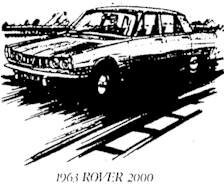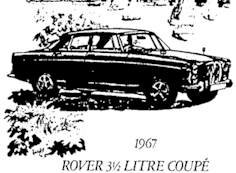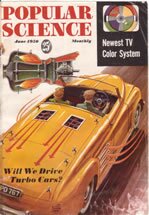|
The year is 1904. In Coventry one of the most successful manufacturing firms in the country is about to embark down a road that's already been the financial and mechanical ruin of others. The Rover Cycle Company, already a leader in the intrepid field of combustion engined motor-cycles, launch their first car - an 8 h.p. dream machine with spoke wheels and coach headlamps.
And call it simply, a Rover.

Events move fast and in 1906 new capital was introduced and with it a new factory title - The Rover Company Limited. Now the problems associated with automobile design and production arc tackled with vigour. The Rover philosophy of investment through commonsense engineering is put into practice.
1907 and a 20 h.p. Rover tourer beats all comers in the International Tourist Trophy Race at the Isle of Man. Names like Audi, Mercedcs Benz, Alfa and so on.

The world was spinning faster for
The Rover Company in 1912 than any other similar manufacturer. In this year they offered a bigger selection of vehicles than any other firm in the world. Ranging from cycles £6.10.0. - £15.2.6, motor cycles from £49-£70, and cars from 100 guineas to £6oo.
The Great War and a further period of expansion for the Rover Company. Government contracts became the order of the day and many a front line soldier depended upon a product of Rover for attack, transport or life-support.
An end to war and the demands for a world rejoicing in peace. Time for leisure and demand for more Rover cars. So in 1919 Rover introduce their most popular car of the era. The Rover 8 h.p. twin air-cooled car. Some 17,000 units of this amazing car were to be a joy to investors in Rovers from 1920-1925 who have never ceased to sing this model's praises.
The Olympia Motor Show London 1924 and Rover introduce the most advanced car of the day-the 14/45 h.p. And collect for themselves the much coveted Dewar Trophy awarded by the Royal Automobile Club. One year later this car made a record-breaking 50 consecutive ascents of the Bwlch-Y-Groes, the famous North Wales Mountain Pass.

Into the 30's with another record. By now Rover have the light-Six and take out the most challenging race of the day, The famous Continental Express the Blue Train, on its 750 mile run across France from St. Raphael to Calais. The Rover Light-Six tackled this 'David' and 'Goliath' challenge and won by twenty minutes over the 20 hour run. The average speed was 38 mph.

The 30's all too soon ran headlong into another war. Again, the Rover Company turned it's expertise to the effort. Only this war saw Rover instrumental in the development of the Whittle jet propulsion gas turbines.
|
|
Peace at last came back. The Coventry factory had been extensively damaged in the blitz. The Company found itself very short of space and by arrangement with the Ministry took over the factory at Solihull where the Rover headquarters remain to this day.
Space wasn't the only shortage post war. Steel was in short supply in 1946/47 and the Government of the day enforced stringent restrictions on its use. Only export orders could qualify for allocations of steel. And under this discipline the Rover Company engineered its most coveted vehicle the Land Rover. To date over 882,000 of these unique work-horses have been produced and many of the original production line vehicles arc still operating in the four corners of the Earth.

In the late 1940's, the P3 designs were introduced - the '60' (4 cyl) and the '75' (6 cyl) with engines of entirely new design in which the cylinder head joint was inclined at an angle to the cylinder block and the side exhaust valve disposed at a considerable angle to the cylinder centre-line. These cars were however destined for short production life and in 1949 the new '75' in the range with its more modern streamlined contours was introduced. The Rover Company investment in the mechanics of the P3 and ultimately its upgrading to the P4 was amply rewarded. The P4 range of cars grew up to include the '60', '80' '90', '100', '105SR' and the '110'. Over 130,O00 of them were produced up to 1964.

The 1950's and the Rover Company astonish the motoring and technical world with the Jet 1 - the world's first gas turbine propelled car. And once again are awarded the coveted Dewar Trophy by the RAC. Quickly followed on from the lessons learnt from the Jet t, the T3 was shown at the Earls Court Motor Show in 1956.
Another jet launch occurred in 1961. This time the T4 was introduced to an amazed public. 'this very attractive car boasted four-wheel disc brakes, independent suspension and front-wheel drive. The 25/140 engine - a two-shaft design - developed 140 b.h.p.

In the 6o's the Owen Organisation co-operated with Rover. The result was a win at Le Mans in that period by being the first gas turbine to be entered and indeed to finish. It's performance figures for the 2,592 mile course included an average of 108 mph.
At the Earls Court Motor Show in 1958 the elegant Rover litre car was presented. The Saloon and Coupe models were the last word in styling, comfort and engineering.
Then in October 1963 the Rover Company's most enterprising creation startled the motoring world - the now famous '2000' became 'The Car of the Year' and has since been universally acclaimed one of the safest cars ever produced.

|
|
Proof of this judgment was the presentation to the Rover Company of the Automobile Association Gold Medal for the 'high degree of inherent safety incorporated in design and construction'. Incidentally, the investment by the Rover Company to build this superb motor was £10,000,000.

1967 was an important year in the history of the company as Rover became part of the Leyland Motor Corporation (now British Leyland). Also in 1967 the highly advanced and efficient 3.5 litre all aluminium V8 was introduced to replace the long serving 3 litre engine from the 50's.

As developed by Rover Company engineers, the engine boasted an extremely flexible power range and afforded a considerable saving in weight.
The 3500 model announced in the spring of 1968 was equipped with the same V8 power unit and automatic transmission as the larger 3.5 litre model, and provided a logical progression for the now famous Rover 2000 concept.
At last into the motoring 70'S and both the '2000' and its previous 3.5 litre derivative, the '3500', received a facelift. New instrumentation, re-styled external features were warmly recognised by the motoring press. In 1971 the 3500S came into being and continues to this day a much sought after car.

The most significant event in 1970 however was the introduction of the Range Rover. Designed to meet the demands of a fast growing 'leisure market'. A car with the tractability of the Land-Rover and the comfort and performance of an exotic motorway limousine.

THE FUTURE
Every Rover over the last 70 years has reflected The Rover Company's belief that the basic principle of good engineering is design efficiency.
Of the future The Times Business News (May 9th 1974) said:
"At Rover some £50m worth of expansion is envisaged at Solihull and supply factories in Birmingham and Cardiff." It went onto promise an even greater future with:
"the new Rover factory at Solihull which will have three assembly lines and a capacity of 3,000 cars per week."
And concluded:
"they could substantially improve their share of the market and make further inroads into Europe."
Rover Triumph, British Leyland
U.K. Limited, Sohihull, Warks.
Telephone: 021 - 743 4242.
|
|














